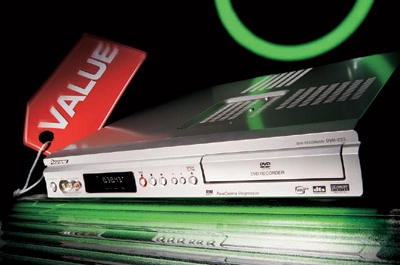DVD Recorders On the Cheap Page 4

|
When I reviewed Pioneer's first DVD recorders in 2001, I didn't imagine their capabilities would ever be available for prices as low as the $259 sticker on the DVR-233. Pioneer has stuck steadfastly to the "dash" (DVD-R/RW) formats since the beginning, and the DVR-233 is no exception. Although it doesn't offer anything new, it's remarkable enough that the DVR-233 manages to perform all the major operations of those first, extremely expensive machines - with one notable exception: playlist editing.
A minor lapse is that there's no front-panel S-video input, which will make it inconvenient to dub an analog camcorder's best output signal. The DVR-233 also lacks an i.Link (FireWire) input for digital dubbing of DV camcorder footage.
Playlist editing has been a perennial feature of Pioneer DVD recorders, but it's missing on the DVR-233. It's the only way to re-order the playback of material already recorded on DVD-RWs, and its absence here might be a deal breaker if you're interested in editing that goes beyond skipping commercials.
Fortunately, even without playlist editing, the deck gives you adequate means for taking out blocks of commercials on DVD-RW recordings - as long as you use the VR mode instead of the less flexible but more widely compatible Video mode. As with the Philips, the Pioneer editing functions operate on chapters - you have to designate a block of commercials as a chapter in order to delete it - but unlike the Philips chapter-hiding procedure, Pioneer's deletion process is not reversible, so think carefully about your chapter designations.
To define a chapter, you use a special onscreen control-panel/menu, with a window showing the program being edited. A similar control-panel/menu is used to delete chapters. The commercial-removal process is easier if you first define all the chapters in a title that contain commercials. Once these are designated, you can quickly march though the title, deleting the offending chapters.
All the cueing controls of the player can be used when you select a chapter point (fast scan, slow motion, and frame stepping, all in forward or reverse, as well as pause and play and the Commercial Skip button on the remote). A timeline showing where the chapter markers are inserted helps you keep track of where you are - a simple yet extremely valuable visual aid that makes Pioneer's editing operations almost as easy as Panasonic's title-shortening function.
The recording quality of the DVR-233 pretty much falls in line with that of previous Pioneer decks. You get full DVD resolution and picture quality in the 1- and 2-hour modes, but horizontal resolution is cut in half starting with the 4-hour mode, producing a much softer picture. Vertical resolution suffered the same fate starting in the 6-hour mode. Pioneer not only provides an 8-hour mode (something its first decks would never have dared) but even a 10-hour one. As you might expect, the three highest-capacity settings produced images riddled with encoding artifacts that got worse as the recording time increased. During a video clip of a football game we use as a DVD-recorder torture test, every player in motion broke up into a mosaic of color blocks. Pioneer's various MPEG noise-reduction controls, the most versatile among these three recorders, provided some relief when turned full up, but not nearly enough.
I'd use the 8- and 10-hour modes only if I were desperate to get as many episodes of a sitcom on one disc as possible - two discs would hold an entire season. Good sitcoms and talk shows depend more on the soundtrack than on the visuals - fortunately, audio quality is preserved in the 8- and 10-hour modes.
If you use the Pioneer DVR-233's extended recording modes (8 and 10 hours) very sparingly, you'll end up with reasonably good video quality most of the time - and excellent quality in the 1- and 2-hour modes. The relative ease of deleting commercials with this deck will have you skipping away.





























































